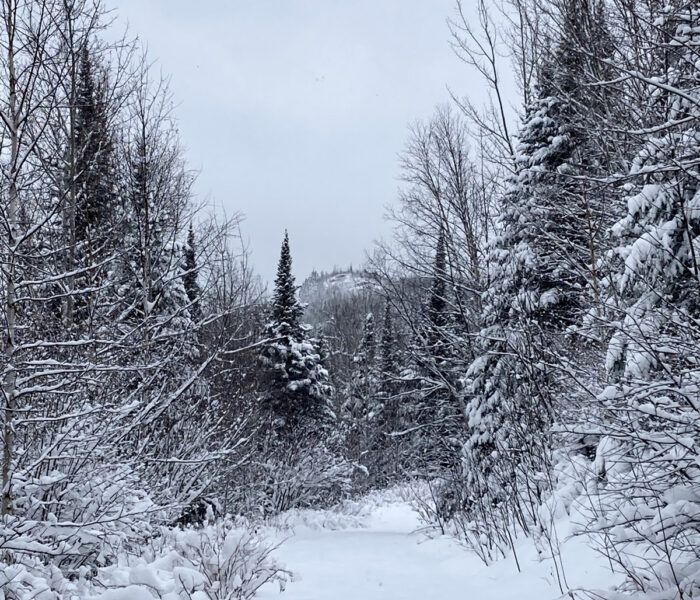Trail Time – Winter is Here!
Winter is here and it came in not like a lamb but like a lion, first with an ice storm and then with about twenty inches of snow. It snowed for days. The trees, already heavy with ice, swayed in the wind, the branches hitting each other — clacking and tinkling as ice cracked. How cozy and sweet it was in our cabin warmed by the fire glowing in the wood stove’s glass window. We were heartened, too, by the knowledge that our woodshed was filled with split and dried birch logs. We had to drive to town on one of those very snowy days. It’s about an eighty-mile round trip for us. This time the drive felt longer because we had to go so slowly due to the icy conditions and the snow falling and drifting. As we headed south, the highway plow passed us heading north, spreading sand. I was glad to see that and glad my drive home would be easier. The only wildlife I saw that day was a Snowshoe hare pin-balling back and forth across the Trail, frantically trying to jump over the snowbanks on the side of the road. Finally the hare gave a mighty leap and I saw it in perfect profile sailing over a pile of snow. The hare had begun its winter transformation to an all-white pelt, but it still had darker hair on its upper parts.
Some animals, like the hare, use protective coloring and some plants create layers of protection against the cold. I had noticed a while ago on one of my forest walks that the mountain ash buds were covered with a sticky resin. I have recently learned why. The resin is formed to protect the buds from winter’s cold and wind. That makes sense, but what I learned next was one of those astonishing nature facts: honeybees use the resin and mix it with their saliva to make propolis, which they use to repair their hive, but also to mummify wasps and mice that sneak into their hive. They sting the unwelcome critters to death and then embalm them in propolis. So wonderfully creepy! Ancient Egyptians used honey to embalm the bodies of their dead royalty. The sarcophagi were sometimes sealed with beeswax and jars of honey were left in the tomb, given as offerings. When King Tut’s tomb was opened, they found a 2,000 year old jar of honey.
Like the animals and plants, we need protection against winters killing cold, too. We don layers of clothing to keep ourselves from freezing. Every year I have to experiment with the rapidly changing weather and re-learn how to dress, first for 50 degrees, then 40, then 30 and on down. I get it dialed in by the end of winter, and I apply my winter camping lessons:
Dress like an onion. That means wear layers you can add or take off as needed.
Cotton is rotten. Damp cotton next to the skin will keep you cool, so it’s great for summer, but rotten in winter. The biggest challenge when you’re active outside in winter is staying dry.
Your head is a chimney. Wearing a hat will keep you warm. You lose a lot of heat through the skull.
If I plan to be out in the woods for a while, I use my pockets or a pack to carry the clothes I shed and extra mittens, gloves and a hat in case something gets wet. I find that wool liners for boots make the best shoes going to and from a hot sauna. They cling to the snow just a bit — no slipping. One year at the first snow I thought it would be so much fun to go outside at night in my new all-leather moccasins. I went up the hill no problem, my toes digging and getting good traction in the new snow. I was just tickled at my silent footsteps and so proud of my cleverness. When I turned to go down the hill toward home— boom! I landed on my keister. The smooth leather soles gave me no purchase. It only took me two more falls to realize that the only way I was getting home safely was on my hands and knees. I crawled down that hill all the way to the cabin with my ego bruised more than my backside. It certainly gave me a new perspective.
A red fox sought shelter from the winter storm under our big woodshed last week. It had a pretty cozy spot under there and was unfazed by human or canine presence. I’m not sure if it was the same fox with an injured leg that showed up on our doorstep last week. Inside the house my dog went bonkers, of course, and the startled fox tried to run straight up our cliff, floundering in the deep snow, then backsliding, then struggling some more. It took it a long time to get over the ridge. Lars had filled and hung our bird feeders a few days before, and I’m sure the fox was attracted by the food on the ground, and maybe the congregation of birds below as well.
The bird feeders herald a new part of the year and it makes me so happy to watch the birds that come to feed. To our delight, we’ve seen pine grosbeaks along with the usual roster of chickadees, blue and gray jays, red-breasted nuthatches, and woodpeckers. A small band of goldfinches stopped by one day and we had a chilling appearance of a northern shrike once more. Man, do the birds disappear fast when the shrike shows up!
I am so thankful for the animals and the birds who liven up winter, and for the breathtaking beauty of the boreal forest wreathed in winter snows.
~ Marcia Roepke











